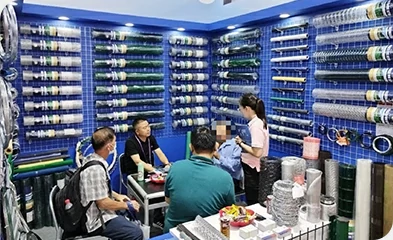 TEL:
+86-13102802206
TEL:
+86-13102802206
 Email:
fencenetting@china.com
Email:
fencenetting@china.com
 Language
Language
 TEL:
+86-13102802206
TEL:
+86-13102802206
 Email:
fencenetting@china.com
Email:
fencenetting@china.com
 Language
Language


Understanding Stainless Steel Cable Ends Applications and Advantages
Stainless steel cable ends play a crucial role in various applications, ranging from marine and architectural to industrial settings. As an essential component of wire rope systems, they provide the necessary termination required for effective load management and safety. In this article, we will explore the various types of stainless steel cable ends, their applications, and the advantages they offer.
What are Stainless Steel Cable Ends?
Stainless steel cable ends, also known as cable terminators or fittings, are devices that provide a secure and strong finish to the ends of wire ropes or cables. They are designed to prevent fraying and ensure that the cable can be safely and effectively attached to structures, equipment, or other cables. Common types of cable ends include swage terminals, crimped terminals, and threaded terminals, which can be customized to suit various sizes and specifications.
Applications of Stainless Steel Cable Ends
1. Marine Industry One of the most significant applications of stainless steel cable ends is in the marine industry. Boats and ships utilize these fittings to secure rigging, anchor lines, and mooring cables. Stainless steel’s corrosion-resistant properties make it an ideal choice for use in saltwater environments, where traditional materials would quickly degrade.
2. Architectural Designs In the realm of architecture, stainless steel cables are often used for structural support, such as in suspension bridges or as railing systems. The aesthetic appeal of stainless steel combined with its strength makes it a popular choice for modern architecture. The cable ends are critical in ensuring that these systems are both functional and visually pleasing.
3. Industrial Applications Many industries, including construction, mining, and manufacturing, rely on stainless steel cables for lifting and rigging. The cable ends are integral in connecting these heavy-duty cables to cranes, hoists, and other lifting mechanisms, ensuring not only strength but also safety in high-stress environments.
4. Automotive Sector Stainless steel cable ends are also used in the automotive industry, mainly in the form of control cables for throttle, brakes, and other mechanisms. The durability and resistance to wear and corrosion make these fittings suitable for use in various automotive applications.

Advantages of Using Stainless Steel Cable Ends
1. Corrosion Resistance One of the most significant advantages of stainless steel is its resistance to corrosion. This quality ensures longevity and reliability in environments where cables are exposed to moisture, chemicals, or extreme weather conditions.
2. Strength and Durability Stainless steel is known for its high tensile strength, which makes it suitable for applications that require the ability to withstand heavy loads and dynamic forces. The durability of stainless steel cable ends reduces maintenance costs and the need for frequent replacements.
3. Versatility Stainless steel cable ends can be manufactured in various shapes and sizes to accommodate different applications and environments. This versatility allows for the customization of fittings to specific requirements.
4. Aesthetic Appeal The sleek and shiny appearance of stainless steel adds a modern touch to any application, making it particularly appealing in architectural designs where visual quality matters.
5. Ease of Installation Stainless steel cable ends are generally easy to install, whether through crimping, swaging, or threading, allowing for quick assembly and reduced labor costs.
Conclusion
In conclusion, stainless steel cable ends are essential components that enhance the performance, safety, and longevity of wire rope systems in a multitude of applications. Their corrosion resistance, strength, versatility, and aesthetic benefits make them the preferred choice for engineers and designers across various industries. As technology advances, the demand for reliable and visually appealing cable termination solutions will continue to grow, further solidifying the role of stainless steel cable ends in modern applications.